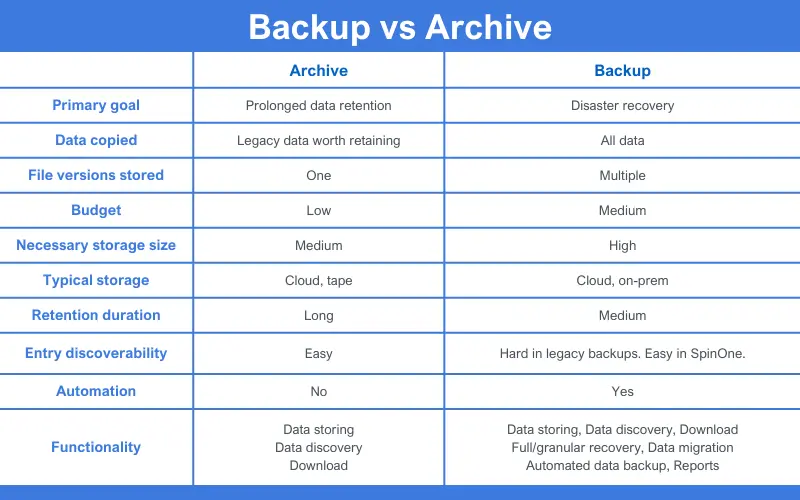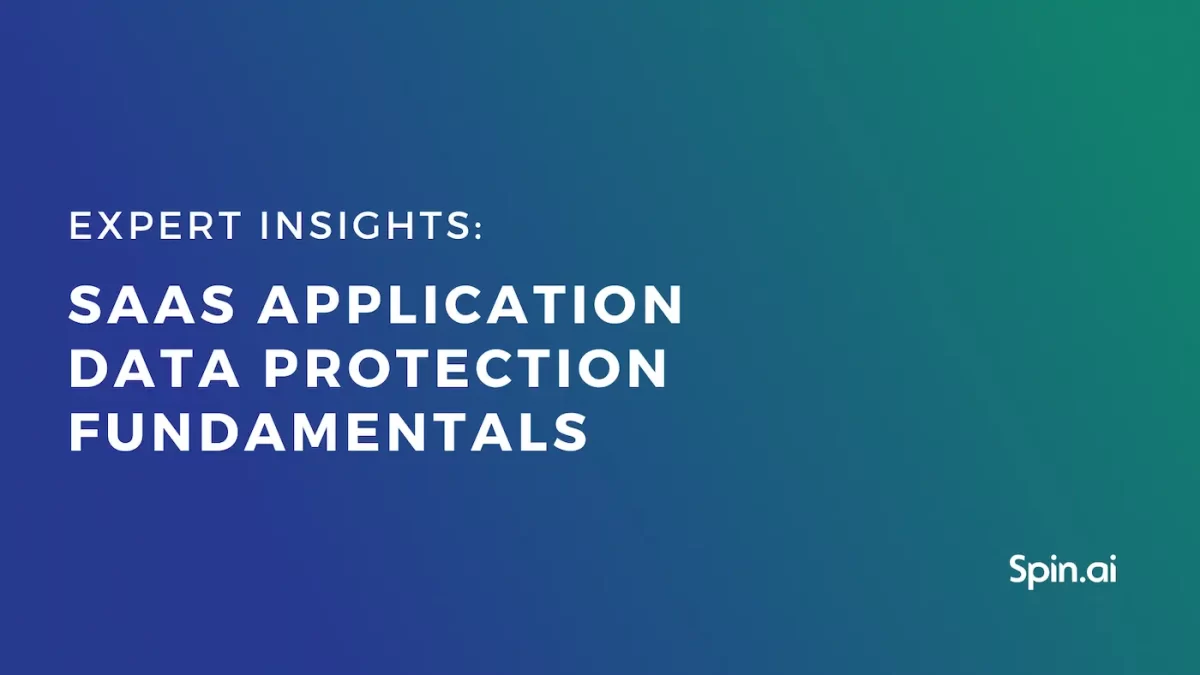Backup Vs Archive: What’s the Difference?

How to preserve your business-critical information? Do you need an archive if you have your backup system? What is the difference between them? In this article, we discuss backup vs archive for SMBs.
What is Data Backup?
Businesses generate information constantly. It is a critical asset for their operations. Firms need to ensure that their employees have unhindered access to their data. And if the information is lost, they can quickly restore it.
Data backup is the up-to-date copy of the data your company will use in case the original is lost or corrupted.
Types of data backups
Backup types depend on several parameters:
- where your data is stored (cloud or on-prem)
- where you want to store your data (cloud or on-prem)
- your storage capacity
- recovery goals.
The four types of backup are full, incremental, differential, and mirror. Learn more about them in our post.
Why back up your data?
Many SMBs do not consider that they need a backup system. Unfortunately, their incorrect assumptions lead to legal fines or even termination of business. Here are two main reasons why you need data backups:
1. Compliance
Countries impose backups on businesses to ensure that necessary data can be accessed at any time. It also aims to prevent businesses from purposefully deleting certain data.
Learn about compliance in the cloud.
2. Disaster recovery and business continuity.
In the modern world, the risk of data loss is big. For example, the 2021 survey revealed that, on average, around one-third of all firm’s folders have no protection.
The key threats to data integrity include the following:
- human error
- ransomware attack
- man-in-the-middle attack
- outage
- zero-day attack.
The severity of outcomes for SMBs is enormous. Up to 70% of small firms will close forever after losing substantial data.
Retrieving files from data backups can help preserve your business and diminish disruption.
Backup solutions
Many companies use backup solutions to automate the backup process and manage backup data easily.
Usually, backup solutions are divided into categories by the location of the data source and data copy (cloud or on-prem). The most popular configuration include on-prem-to-on-prem and cloud-to-cloud. Some modern cloud-to-cloud backups also have a data archive system.
These tools have convenient recovery functionality. It is especially important, for example, in case of a ransomware attack. Third-party backup can provide fast Drive and Gmail recovery.
What is Data Archiving?
From the data management perspective point of view, all organizational data can be divided into two categories: data in use and legacy data. You would want to back up the former and manage the latter.
When it comes to legacy data, any information owner should analyze whether they need it or not. The unnecessary records are subject to elimination. The necessary ones must be stored. Keeping them in a separate location is better since it improves their security.
Data archiving is retaining data for a long time in independent storage.
The requirements for the data archiving system:
- high security
- easy accessibility
- effortless discoverability
Why does your business needs data archiving?
1. Compliance.
Many countries mandate the retention of certain types of data even if an organization doesn’t need it anymore for its operations. For example, Universities must store the records of their students, and hospitals must keep the entries of their patients. Construction firms must preserve the blueprints of the buildings they erected for decades.
2. Data retention.
Even when it’s not imposed by laws, some data should be preserved. For example, an organization can use one project’s information to boost another’s performance or analyze weaknesses and strengths. The archive data can provide creative solutions.
3. Cost saving
Data archiving usually costs less than using regular storage or backups. On-prem archive solutions are low-performance hardware with simple functionality, usually tape. When it comes to cloud tools, the archive is cheaper because it has simple functionality.
The Differences Between Backup and Archiving
Before talking about backup vs archive differences, we want to spot a number of superficial similarities that confuse some people into believing they are the same.
Similarities between backup and archive
1. Both copy business data to remote storage for its preservation.
2. Backups and archiving are essential for business continuity and are a part of data management.
3. Both storage spaces require enhanced security
4. You can purchase tools that facilitate these processes.
And that’s where their similarities end.
Backup vs Archive: Comparison Chart
We compiled all the differences in one simple table that we also turned into an infographic.
We’d like to comment on three differences backup vs archive that we mentioned in the table:
1. Necessary storage size.
Some sources argue that the storage size of archived data is bigger than that of a backup because it has accumulated historical data. However, in our opinion, it’s not true. As we mentioned before, the archive contains only the most valuable entries. But backup copies all the data, sometimes several times a day, and it preserves versions. That’s why by design, it cannot be smaller (unless the company has shrunk tenfolds).
2. Discoverability
Most legacy backup solutions do not retain data hierarchy. That is why data discoverability is problematic. And the recovery of many files will mess up with your folder record hierarchy.
The backup data in tools like SpinOne is structured (by folders, days of snapshots, and services) and can be easily found.
3. Automation
An archive cannot be automated because you first need to sift the data and only then store it. If you don’t do it, you might end up with full storage way too soon.
Meanwhile, automation of the backup process is essential because its regularity guarantees data protection.
Why You Need Both Backup and Archive
Both backup and archive are essential for business continuity for several reasons. First, they pursue different cybersecurity goals and retain different types of data. And both types of stored data are equally important for a firm.
Imagine a company that doesn’t have a backup tool. When data loss happens, such a business will have to spend months, if not years, to create a similar amount of data from scratch. Furthermore, the legal consequences of such an event can be devastating.
Why not store and use archives like backup and save money? First, there is no automated data copying. Second, archives usually have slower performance. Third, they don’t have the technology of incremental or differential backup, which allows for making copies faster. Finally, they do not store versions of files which at times can be critical for a business.
Now imagine a company that doesn’t have an archive. It won’t be able to comply with existing laws. Also, it will lose access to the valuable data that it has accumulated over the years of its existence. Why not use a backup as an archive? Above all, because it costs more.
Understandably, companies, especially small and medium ones, want to use as few IT tools as possible for easier management. That’s why solutions like SpinOne offer both archiving and backup. Let’s take a closer look at how it works.
SpinOne – Backup Solution with Archive Capabilities
SpinOne is a cloud-to-cloud incremental backup with the possibility to store archive data. We work with three SaaS cloud solutions and their respective services:
- Google Workspace (Gmail, Drive, Calendar, Contacts, Shared Drives).
- Microsoft Office 365 (Outlook, OneDrive, Calendar, People, Sharepoint).
Related Link: How to Back Up SharePoint
SpinOne benefits for SMBs:
- Automated daily backups
- Unlimited storage space on GCP, AWS, or Azure
- Ability to choose data center location
- Data management functionality (e.g., data migration or downloads)
- EU Privacy Shield, SOC 2, and GDPR compliance
- Point-in-time recovery of a single file or a whole snapshot
- Preservation of files hierarchy and easy discoverability
- Storage of archived data at a lower price
- Comprehensive reporting
Was this helpful?
How Can You Maximize SaaS Security Benefits?
Let's get started with a live demo
Latest blog posts
How to Restore A Backup From Google Drive: A Step-by-Step Guide
April 10, 2024Backing up your Google Drive is like making a safety net for the digital part... Read more
Protecting Partner Margins: An Inside Look at the New Spin.AI Partn...
April 2, 2024Google recently announced a 40% reduction in the partner margin for Google Workspace renewals –... Read more
Expert Insights: SaaS Application Data Protection Fundamentals
March 21, 2024SaaS applications appeal to organizations because they make running the application “somebody else’s problem.” However,... Read more



